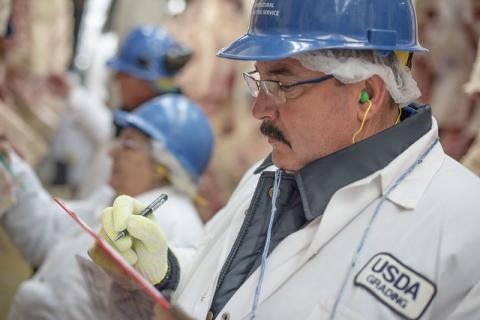USDA’s Role in Addressing Antimicrobial Resistance
The United States Department of Agriculture (USDA) is responsible for protecting American agriculture and the American food supply. One of the many ways USDA does this is by addressing antimicrobial resistance (AMR). The USDA AMR Strategy (PDF, 1.6 MB) identifies priorities in the terrestrial and aquatic food and agriculture sector to accelerate our understanding of and minimize the risk from AMR.
- USDA AMR Strategy
-
The Strategy is organized around three Areas of Focus and ten Priorities for collaborative action by USDA and its public and private partners:
- Area of Focus 1: Reduce disease and pathogen transmission to reduce AMR risk.
- Priority 1: Improve animal and crop health.
- Priority 2: Promote biosecurity.
- Priority 3: Promote food safety.
- Area of Focus 2: Improve the scientific knowledge base on AMR risk.
- Priority 4: Continuously improve data infrastructure using a One Health approach.
- Priority 5: Support science and research across sectors to inform risk analysis.
- Priority 6: Improve understanding of drivers of antimicrobial use
- Priority 7: Enhance feedback loops between 1) monitoring and surveillance; 2) research; and 3) education and outreach.
-
Area of Focus 3: Improve communication and collaboration within USDA and with national, regional, and global partners to address AMR risk.
- Priority 8: Enhance partnerships through building trust.
- Priority 9: Improve knowledge dissemination and include contextual information.
- Priority 10: Develop and deliver science-based solutions locally and globally.
- Area of Focus 1: Reduce disease and pathogen transmission to reduce AMR risk.
- What is AMR?
-
AMR is a natural process in which bacteria continually evolve to resist and survive substances that should kill them, whether these substances are produced by the environment, other bacteria, fungi, other microbes or are antibiotics developed by people. AMR bacteria are everywhere–intimately linked with humans, soils, plants, and in food-producing and companion animals. One important aspect of AMR is that some bacteria develop resistance to antibiotic drugs, resulting in loss of effectiveness of those drugs.
Many human activities such as medical and veterinary treatments or disposal and transport of human sewage and animal waste can affect the number and kind of resistant bacteria in people, animals, and the environment.
Antimicrobial treatments are used to help sick human and animal patients overcome their illnesses and to help prevent the spread of diseases. Bacteria can develop a resistance to these treatments, which makes them less effective. To reduce the chances for development of antimicrobial resistance, we need to be careful with how and when we use them.
Read more: USDA describes the work it does to address AMR in its USDA Strategy to Address AMR (PDF, 1.6 MB)
- What does USDA do to address AMR?
-
USDA works alongside many partners to limit and counter AMR. Here are some examples of USDA’s ongoing efforts on AMR:
USDA Protects Public Health
- Conduct research on the farm, in the lab and at processing facilities to identify solutions to AMR risks to human health
- Conduct monitoring and surveillance and improve epidemiological methods in foodborne illness investigations
- Collaborate with and inform public health agencies, including the Centers for Disease Control and Prevention and the Food and Drug Administration
- Participate in foodborne outbreak investigations with public health partners
USDA Protects the Meat and Poultry Supply
- Test meat and poultry for AMR bacteria and antimicrobial residues
- Inspect slaughter/processing plants for safe practices and ensure that food is safe, nutritious, and wholesome, and correctly labeled
- Research ways to improve best management practices to reduce AMR in agricultural settings
- Evaluate management practices to optimize animal health and reduce the need for antimicrobials
USDA Evaluates Antimicrobial Use in Livestock
- Conduct surveys of animal health, including antimicrobial use and stewardship
- Research how animal management can affect antimicrobial use
- Develop alternatives to antibiotics in food producing animals
- How does USDA Collaborates with Others to Share Information and Leverage Resources?
-
- Collaborate with the private sector, non-governmental organizations, commodity and industry organizations, universities and State and Federal agencies
- Partner with countries to share technical information and enhance the capacities of governments, non-governmental organizations, academia, and the private sector
- Coordinate within international organizations on science and risk-based activities to understand antimicrobial use and resistance and develop guidance
- Work with industry and the other Federal and state partners to reduce pathogens and AMR in foods
- Collaborate with public and private partners to identify research gaps, conduct applied research and implement mitigation strategies to reduce AMR risks associated with their products
Resources:
- The Departments of Health and Human Services, Agriculture, and Defense co-chair the Combating Antibiotic Resistant Bacteria (CARB) Task Force and are currently implementing the CARB National Action Plan 2020-2025
- Progress reports on the CARB National Action Plan
- USDA-FSIS National Antimicrobial Resistance Monitoring System (NARMS) Webpage
- USDA-FSIS NARMS Quarterly Tables
- The 2021-2025 NARMS Strategic Plan
- Publicly available Whole Genome Sequence and AMR data: National Center for Biotechnology Information (NCBI)
- USDA ARS Research on AMR and Alternatives to Antibiotics
- USDA-ARS AMR Accomplishment Summary 2016-2018 (PDF, 3.5 MB)
- USDA ARS AMR/Alternatives to Antibiotics Accomplishment Summary 2019-2021 (PDF, 1.3 MB)
- U.S. National Residue Program
- USDA APHIS National Animal Health Monitoring System (NAHMS)
- USDA APHIS National Veterinary Accreditation Program (NVAP)
- USDA APHIS National Animal Health Laboratory Network (NAHLN) AMR Project
- Food Animal Residue Avoidance Databank (FARAD)
- USDA ARS Animal Health Action Plan
- USDA ARS Food Safety Action Plan
- Transatlantic Taskforce on Antimicrobial Resistance (TATFAR)
- What are the roles of different USDA agencies in addressing AMR?
-
- The Agricultural Marketing Service (AMS) provides voluntary verification of stakeholder antibiotic processes and standards through the USDA Process Verified Program.
- The Agricultural Research Service (ARS) uses multidisciplinary approaches, conducting research across the One Health spectrum to detect, mitigate and improve the understanding of AMR and its impacts. AMR crosses four ARS program areas: Animal Production and Protection; Nutrition, Food Safety and Quality; Crop Production and Protection; Natural Resources and Sustainable Agricultural Systems.
- The Animal and Plant Health Inspection Service (APHIS) leads the collection of cross-sectional and longitudinal data on food animal antibiotic use practices, biosecurity, and management practices, animal health status, and antimicrobial susceptibility profiles in pathogenic and other bacteria on farms, as well as monitoring of AMR in Salmonella and other pathogens from clinically ill animals and wildlife via diagnostic laboratories and networks. APHIS approves veterinary biologics including vaccines used to prevent and control disease in animals. NAHMS studies collect on-farm national-level antibiotic use, health, and management data. APHIS works with producers and industry groups to implement animal health and biosecurity plans.
- The Economic Research Service (ERS) analyzes farm management practices related to antimicrobial use, including the effects of antibiotic use on farm production, costs, and revenues. ERS also evaluates the effects of market changes on trends in antibiotic use in animals and provides estimates of the extent of antibiotic use among different species and at different stages of production. In addition, ERS analyzes the effects of changes in farm productivity, costs, and prices on domestic and international markets for agricultural commodities and food products. As part of that effort, ERS maintains extensive databases on the farm sector economy.
- The Food Safety and Inspection Service (FSIS) is the public health regulatory agency of the U.S. Department of Agriculture (USDA) responsible for ensuring that domestic and imported meat, poultry, and egg products are safe, wholesome, and accurately labeled. Consistent with its role, FSIS’ mission is to protect public health by preventing illness from meat, poultry, and egg products. The NARMS program at USDA FSIS focuses on sampling and testing of intestinal cecal contents, carcasses, and meat and poultry by FSIS.
- The Foreign Agricultural Service (FAS) links U.S. agriculture to the world to enhance export opportunities and global food security. FAS serves as the eyes, ears, and voice of U.S. agriculture around the world, promoting U.S. exports, assessing market conditions and opportunities, removing trade barriers, and supporting agricultural development. FAS provides technical and financial support for AMR initiatives in Africa, Latin America, and elsewhere, and also works with trading partners and international organizations to establish and maintain science-based rules and standards that facilitate trade.
- The National Agricultural Statistics Service (NASS) provides timely, accurate, and useful statistics in service to U.S. agriculture. In addition to working in cooperation with other USDA agencies on antimicrobial use surveys, NASS’s Agricultural Chemical Use Program is the federal government’s official source of statistics about on-farm and post-harvest commercial pesticide use and pest management practices.
- The National Institute of Food and Agriculture (NIFA) is USDA’s extramural research, education and Extension funding agency, investing in and advancing science to solve societal challenges. Numerous NIFA funding mechanisms support research, education and extension initiatives to better understand and mitigate AMR in the agricultural environment and throughout the food chain.
- The Office of the Chief Scientist (OCS): Supports scientific prioritization and coordination across the Department ensuring that research supported by and scientific advice provided to USDA and its stakeholders is held to the highest standards of intellectual rigor and scientific integrity.
- The Office of Pest Management Policy (OPMP) develops and coordinates USDA policy on pesticides, integrated pest management, biotechnology, and related topics.
- What is the relationship between antibiotic use in agriculture and AMR bacteria?
-
Antibiotic use on farms and AMR bacteria found in food do not have a one-to-one relationship. While some believe antibiotic use in agriculture is one of the primary drivers for AMR emergence, the fact is we have an incomplete understanding of the factors that contribute to AMR in various settings.
USDA Agricultural Research Service (ARS) and National Institute of Food and Agriculture (NIFA) projects on farms, in fields, and at processing facilities are developing a much more refined understanding of how and why resistant bacteria evolve and how they become present in our food production systems. Such studies show how complicated AMR actually is, especially as we try to understand how it occurs in systems as big in size and diverse in purpose as livestock and poultry production, crop production and food processing.
Protecting public health and the integrity of the food production system is USDA’s priority. Our work is focused on developing a science-based understanding and solving actual risks of AMR in agriculture: how to keep the food supply safe, rather than simply focusing on where AMR bacteria can be found. AMR bacteria are found everywhere in nature so we must focus on how that translates to real risks.
ARS researchers have found that cattle raised with standard practices and those raised without antibiotics have similar levels of resistant bacteria. In another study, when manure from beef cows was added to soil plots, the levels and types of resistant bacteria were very similar to that found in soil plots that only nutrients such as sugar had been added.
For more information about these studies, see:
- Specific Antibiotic Resistance Goals (2020)
- Antimicrobial Resistance in U.S. Cull Cow Processing (2020)
- No Change in Risk from Antibiotic Resistant Salmonellosis from U.S. Beef (2020)
- Cropland Amendment with Beef Cattle Manure Minimally Affects Antimicrobial Resistance (2019)
- Antimicrobial Resistance in Beef Cows (2016)
- Antimicrobial Resistance in the Beef Continuum (2015) (PDF, 281 KB)
- How does the amount of antibiotics used in food animals in the United States compare to the amount used in other countries?
-
Comparisons of antibiotics used or sold between countries are often inaccurate and can be misleading.
- Sometimes comparisons are made between antibiotic sales and antibiotic use data. “Use” and “sales” data are not the same. Further, differences in animal populations, weights, and production practices differ between countries and can influence results. For more information, please read FDA Releases Annual Summary Report on Antimicrobials Sold or Distributed in 2020 for Use in Food-Producing Animals.
- Ionophores are a class of antibiotics that are only used in animals and are not known to promote resistance to antimicrobials of human importance. Ionophores account for 35% of the total U.S. antibiotic sales reported in 2020. In many countries, ionophores are used, but not regulated as antibiotics and not included in antibiotic sales or use totals.
- Estimates of antibiotic use are difficult to calculate and there is no global “gold standard” for such a metric. For more information on antibiotic use in food animal sectors in the United States see the special issue of Zoonoses and Public Health which highlights the findings from on-farm pilot studies.
- Is meat from animals that have never had antibiotics free from AMR bacteria?
-
The short answer is no. This is because regardless of whether or not an animal is treated with antibiotics, bacteria including those that may be resistant to certain antibiotics may be present on raw meat. Proper cleaning, separating, cooking, and chilling are always necessary.
- Does meat from animals that were treated with antibiotics contain antibiotic residues?
-
FSIS-regulated meat and poultry is regularly tested for antibiotic residues under the National Residue Program. This comprehensive regulatory program ensures the safety of U.S. meat, poultry, and egg products, by inspecting, testing and ensuring that harmful residues are not present in these products.
You may visit the FARAD website to find out more about residues.
The terms antibiotic resistance and antibiotic residues can sometimes be confusing although these have distinctly different meaning. Further information can be found in the FSIS AMR Q/As and the Process Verified Program.
What do labels about antimicrobial use mean? View the Livestock and Poultry Auditing & Verification page to see more about labeling.
- Is AMR increasing?
-
There isn’t a simple yes or no answer to this question. Resistance trends need to be evaluated by bug-drug-species combinations rather than simply stating that all resistance is increasing or decreasing.
For example, data from the most recent NARMS Integrated Report provides information on AMR trends for foodborne bacteria. According to data reported, for 2020, the majority (81%) of Salmonella isolates from humans were not resistant to any of the antimicrobials tested. In humans, the overall level of resistance remained relatively unchanged from 2019 and was in line with other data from 2006-2018, when 76-85% of Salmonella isolates tested were susceptible to all antimicrobials tested.
The Center for Disease Control and Prevention (CDC) highlights the most important AMR threats to human health in the 2019 Antibiotic Resistance Threats Report.
- If any use of antibiotics can lead to AMR, why are antibiotics used in animal agriculture?
-
Animals get sick sometimes, just like people do. Veterinarians can treat bacterial diseases in animals with antibiotics. For example, recently weaned piglets are susceptible to respiratory disease and diarrhea. Veterinarians can administer antibiotics to piglets in feed or water to treat these illnesses and reduce unnecessary suffering.
Antibiotics are just one of the tools producers use to address animal disease on their farms and ranches. They also prevent or address diseases by following strict biosecurity practices, having a vaccination program, and following an early disease detection plan.
The USDA National Animal Health Monitoring System conducts periodic studies of animal agriculture and routinely collects information about antibiotic use and stewardship practices on farms.
For more information about these studies, see:
- How does USDA engage internationally on AMR?
-
USDA Activities
USDA relies on sound science and risk-based approaches in its decision-making. Activities focus on:
- monitoring and surveillance;
- research and development; and
- education, and outreach.
These activities help determine patterns of antibiotic use in food producing animals; monitor antibiotic drug susceptibilities in food animals, meat and poultry; and develop mitigations to reduce AMR associated with food production environments. The Collective Antimicrobial Resistance Ecosystem diagram (PDF, 54.1 KB), shows how human and animal ecosystems are interconnected under the "One Health" approach/concept. Detecting and controlling antibiotic resistance requires the adoption of this approach to disease surveillance as it recognizes that resistance can arise in humans, animals and the environment.
The findings and gaps identified in a USDA-sponsored workshop in May 2012 were used to help develop the USDA Antimicrobial Resistance (AMR) Action Plan (PDF, 322 KB) in 2014. In 2022, USDA held a public meeting to share what the Department and its partners had learned in the past decade, and solicited public input on furthering scientific knowledge on AMR. USDA considered historical and collective experience as well as comments received in developing the USDA Strategy to Address Antimicrobial Resistance (PDF, 1.6 MB) in 2023.



